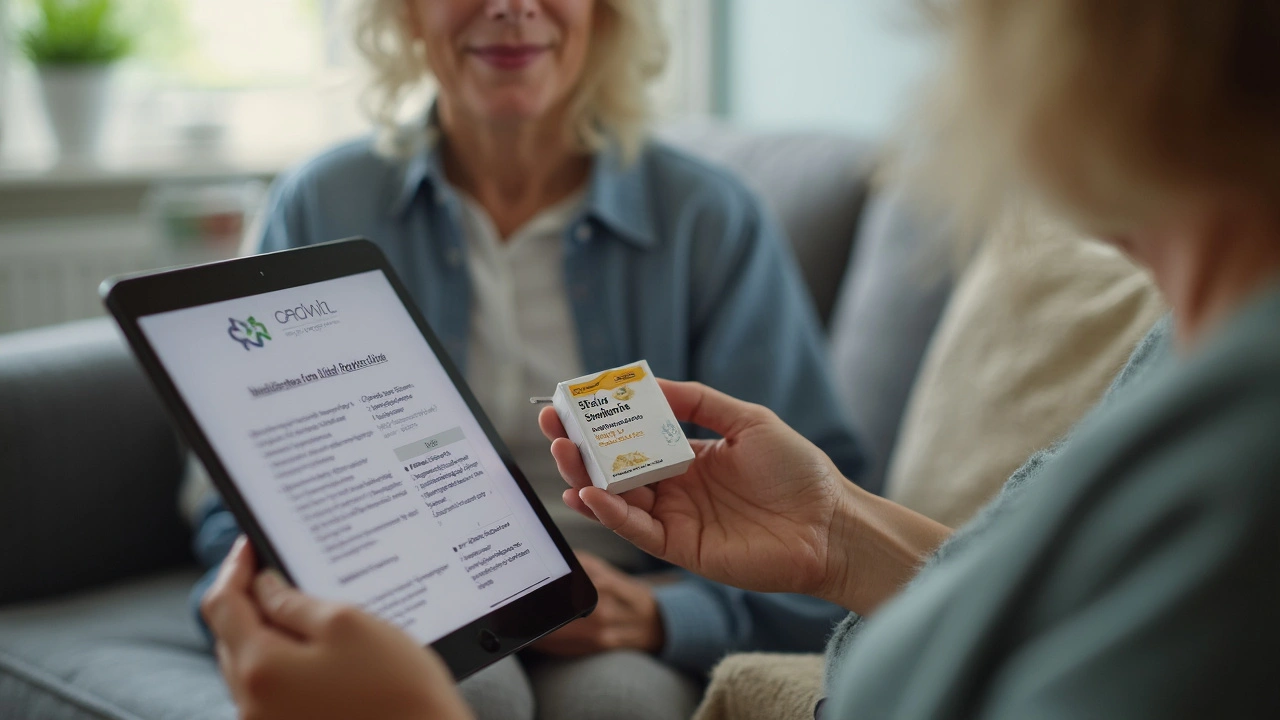If you take didanosine or look after someone who does, there's a world of things doctors don't always tell you upfront about drug interactions. Mixing medications isn't just a simple matter of what goes in and what comes out. Sometimes it’s more like a chemical lottery ticket, with unlucky winners getting unexpected side effects. Didanosine, used for managing HIV, has a habit of getting into arguments with other meds—not just a minor squabble, but a full-on shouting match. That’s why every pill, supplement, or sip of something new can shift the odds. It sounds dramatic, but the consequences can be serious. People have ended up back in the hospital just because their heartburn meds clashed with their HIV treatment. That’s how tricky didanosine can be. So if you’re thinking all pills play nice together—think again.
How Didanosine Works and Why Interactions Are a Big Deal
Let’s get a grip on how didanosine does its job before getting tangled up in the world of interactions. Didanosine, known to mates in the medical world as ddI, is a nucleotide reverse transcriptase inhibitor (NRTI). That’s a mouthful, but the idea is simple: it blocks HIV’s ability to replicate. The virus uses your cells like a workshop, cranking out more copies. Didanosine wrenches the process to a halt, giving your immune system the breathing space it needs. But—and it’s a big but—didanosine is picky about its company. It’s sensitive to changes in pH (the acidity of its environment), and it needs to be absorbed in just the right conditions to work best. Pop it at the wrong time, or take it with something it doesn’t like, and its effectiveness can fall off a cliff. Sounds a bit fussy for a life-saving med, but that’s the deal. Didanosine also stresses out your pancreas and can stir up peripheral neuropathy, a nerve condition that causes tingling or pain, mostly in your hands and feet. So, when you start stacking other drugs on top, you don’t just risk didanosine losing its punch—you’re also flirting with unexpected side effects that neither you nor your doctor might see coming.
Interactions can happen in two ways: Some medications make didanosine weaker, so your HIV treatment falls short. Others might crank up the side effects, creating problems that are harder to manage. For instance, medicines that affect the same organs (like your liver or kidneys) might force them to work overtime, or increase the risk of toxicity. A classic example is when people mix didanosine with ribavirin—a drug used in hepatitis C treatment. This combi can cause dangerous effects on your pancreas or liver, which is why experts now recommend never using them together. Even simple things like antacids, food, or vitamin supplements can mess with how didanosine is absorbed by your body. And with Melbourne’s growing multicultural population, access to herbal remedies and imported supplements is easier than ever, so the interaction risk has grown. Essentially, if you’re on didanosine, you need to check and double-check every other pill, powder, or potion you consider adding.
Common Drug Interactions to Watch Out For
If you’ve ever gone down a pharmacy aisle and felt overwhelmed by the number of choices, you’re not alone. Add didanosine to the mix, and suddenly even regular cough syrup starts to look suspicious. Let’s break down the usual suspects when it comes to problematic interactions.
- Antacids and Acid Reducers: Didanosine’s absorption relies on the acidity in your stomach. Common antacids like Maalox, or acid blockers such as omeprazole, lansoprazole, and famotidine, can make the stomach less acidic. If you take them too close to your didanosine dose, you might soak up much less of the medicine than you’re meant to. The trick is to separate dosing by at least two hours, but honestly, even pharmacists get confused about the timing sometimes.
- Ribavirin: Both of these drugs are tough on the liver and pancreas, and when used together, the risk jumps up. This combo has led to reports of fatal liver failure and lactic acidosis, a dangerous build-up of acid in the blood. It's a huge red flag and, in many Australian guidelines, this mix is considered a no-go.
- Allopurinol and Tenofovir: Allopurinol, usually prescribed for gout, can boost levels of didanosine in your blood, pushing side-effect risk higher—think pancreatitis, nerve pain, or vision problems. Tenofovir, another HIV drug, also raises didanosine levels. This double-whammy can be a recipe for disaster, leading some HIV specialists in Melbourne to avoid this combination altogether unless there’s no other choice.
- Alcohol and Supplements: Yes, supplements. That daily multivitamin or herbal ‘immune booster’ from the health food store can change how much didanosine your body actually gets. For instance, any supplement high in magnesium or calcium, like antacids or some protein powders, will stick to didanosine and carry it straight out the other end, never giving your body a chance to use it.
- Protease Inhibitors and NNRTIs: These are other classes of HIV meds, and while some can be used alongside didanosine safely, others, like atazanavir, cause the didanosine levels to skyrocket or plummet unpredictably. It’s a juggling act only a knowledgeable HIV specialist should manage, with loads of blood test monitoring.
- Antibiotics: Some, like tetracyclines or quinolones, need to be spaced away from didanosine just like with antacids, or risk not being absorbed properly.
One thing that might surprise you: food itself. Didanosine works best on an empty stomach, but ‘empty’ means at least 30 minutes before or 2 hours after eating. Miss this window, and you lose some of the drug’s punch. And let’s be honest, life doesn’t always work around strict medication timing. That’s why a lot of people in the Melbourne Positive Living Centres work with pharmacists to sort out pill organizers or reminders on their phones.
On top of all that, some lesser-known medications have occasionally popped up in reports of serious interactions—everything from antifungals to anti-seizure medicines, and even some antidepressants. The Melbourne Clinical Pharmacology Network keeps a running list that gets updated almost every three months, and it’s always worth asking your pharmacist or doctor to double-check anything new.

Managing Risks: Tips and Real-Life Strategies
You don’t need a pharmacy degree to manage didanosine, but you do need to be smart and, honestly, a bit stubborn. The first big tip: get organised. Write down every medication, supplement, and herbal product you use—even if it’s just a vitamin. Hand this list to every doctor, dentist, and pharmacist you see. Some people in town even keep a photo of their med lineup on their phone; it’s quick, and no one forgets a thing under pressure.
Timing is everything with didanosine. Most people are told to take it on an empty stomach, but this can get complicated if you’re juggling other pills or just have an unpredictable eating schedule. If you miss the empty stomach window sometimes, don’t panic, but do try to stick to the routine. Set alarms or use a pill organizer—whatever helps you remember. In fact, a recent survey in eastern Melbourne’s HIV support groups found that people using smartphone reminders were 40% less likely to miss their dose timing than those relying on memory alone. That’s a real, practical difference.
If you’re starting any new medication or supplement, check with your pharmacist first. Sometimes even they need to look things up, especially now that people can get supplements from overseas, with unlisted ingredients being a risk many don’t see coming. Australian pharmacists are trained to double-check combinations and look for red flags, so take advantage of that training.
Don’t underestimate the risk of herbal supplements. Melbourne’s got a thriving alternative medicine scene, and some products from local markets have been found with hidden heavy metals or unlisted meds. Just because it’s ‘natural’ doesn’t mean it’s safe with didanosine. There’s been a case at the Alfred Hospital where an imported supplement interacted with an HIV regimen and led to kidney damage after just two weeks. So double-check, every time, no matter how tame it seems.
Symptoms like fatigue, pins-and-needles, an upset gut, yellowing of the eyes, or chest pain can all signal a brewing interaction problem. Don’t sit on it—book in with your doctor or nurse as soon as you notice anything off. Early tweaks to your meds can make all the difference, and in most cases, you’ll be back to normal in no time if you act quickly.
Here are some quick action steps to manage your risks:
- Always take didanosine interactions seriously—ask before mixing any new drug or supplement.
- Keep your medication list up to date and show it to every new healthcare provider.
- Stick to scheduled pill times as best as you can; use alarms or phone reminders if needed.
- If you miss a dose or mess up the timing, don’t double up—just return to the schedule and let your healthcare team know.
- Watch for unusual symptoms and report them early; don’t chalk them up to stress or just bad luck.
- Let a pharmacist or HIV specialist review your combination of meds, especially after any changes.
The bottom line: Stay alert, stay organised, and never feel like you’re being a burden by asking questions. Melbourne’s healthcare professionals are used to complicated cases, and they’d much rather field your questions early than solve a preventable crisis later. Didanosine can be a brilliant tool in fighting HIV, as long as you help it avoid the wrong company.
Talking with Your Healthcare Team: Questions Worth Asking
One of the things people forget is that doctors and pharmacists aren’t mind readers. If you want to get the most out of didanosine—and keep yourself safe from those unwanted interactions—you’ve got to speak up. Write your questions down if you tend to forget them, or text yourself reminders for your next appointment. That little step can save a lot of trouble.
Here are some solid questions to throw at your pharmacist or doctor when you’re starting or reviewing your HIV treatment plan:
- How should I space my didanosine from meals, supplements, or other medications?
- Are there any over-the-counter drugs or herbal products I should avoid? What about those imported from overseas?
- Is it safe for me to take antacids, heartburn medications, or vitamin supplements, and how should I time them?
- If I need antibiotics or painkillers, which ones are safest with didanosine?
- What symptoms should make me seek help right away?
- Am I at extra risk because of my age, other health conditions, or medicines?
- How often will you check my blood tests or monitor me for side effects?
- Can you update my medication list and double-check for new or rare interactions?
Even if you think something is ‘probably fine’, call anyway. There are no silly questions when it comes to HIV treatment and didanosine—everyone in Melbourne’s clinics has heard weirder than whatever you’re worried about. If you ever do run into an issue, keep notes about symptoms: when they started, what they feel like, and what changed. This can help your healthcare team spot a subtle interaction much faster.
And don’t forget, protocols change. Treatment guidelines from just a couple years ago can be seriously out of date. Melbourne clinics are plugged into the latest national and international research, which can mean unexpected tweaks if, say, some new study from the Doherty Institute finds a safer way to combine meds or flags a new risk. Trust your team, but stay curious and up to date yourself.
The trick with didanosine is to always treat it with the respect it deserves. Drug interactions aren’t just a technicality—they can affect your health in ways you wouldn’t expect. Talk things through with your team, keep your list up to date, and never stop asking questions. Stay one step ahead, and didanosine will stay an ally, not a liability, in your HIV treatment plan.







May 6, 2025 AT 23:06
If you’re wrestling with didanosine and a laundry list of meds, the first rule is to treat every pill like a potential landmine. Doctors may hand you a prescription, but they often skim over the biochemical fireworks that happen when drugs collide. For example, antacids raise stomach pH and can drop didanosine absorption by up to 50 percent, effectively turning a full dose into a half‑dose. That half‑dose may not suppress the virus enough, giving HIV a chance to rebound. On the flip side, drugs like allopurinol or tenofovir can boost didanosine plasma levels, pushing toxic thresholds and risking pancreatitis. Pancreatitis isn’t a mild stomach ache; it can lead to organ failure and requires intensive care. Combine that with ribavirin and you’re flirting with lethal liver injury, a scenario that has already claimed lives. Even over‑the‑counter supplements loaded with magnesium or calcium can chelate didanosine and escort it straight out of your system. The takeaway? Timing is everything – you need a two‑hour gap between didanosine and any acid‑altering agent. Set alarms on your phone, use a pill organizer, and never assume a pharmacist will catch every interaction. If you notice tingling in your hands or feet, don’t write it off as ‘just nerves’ – it could be early peripheral neuropathy. Report any yellowing of the eyes or unexplained fatigue to your clinician immediately; early intervention can reverse damage. Keep a running list of every substance you ingest, including herbal teas and imported supplements, and share it at each appointment. Ask your HIV specialist to order regular liver and pancreatic enzyme panels; proactive monitoring saves lives. In short, treat didanosine like a high‑maintenance partner – it demands attention, discipline, and constant communication, or the relationship will end badly.